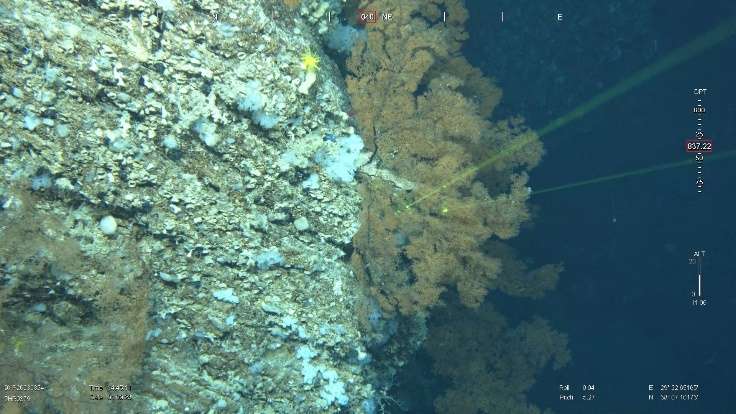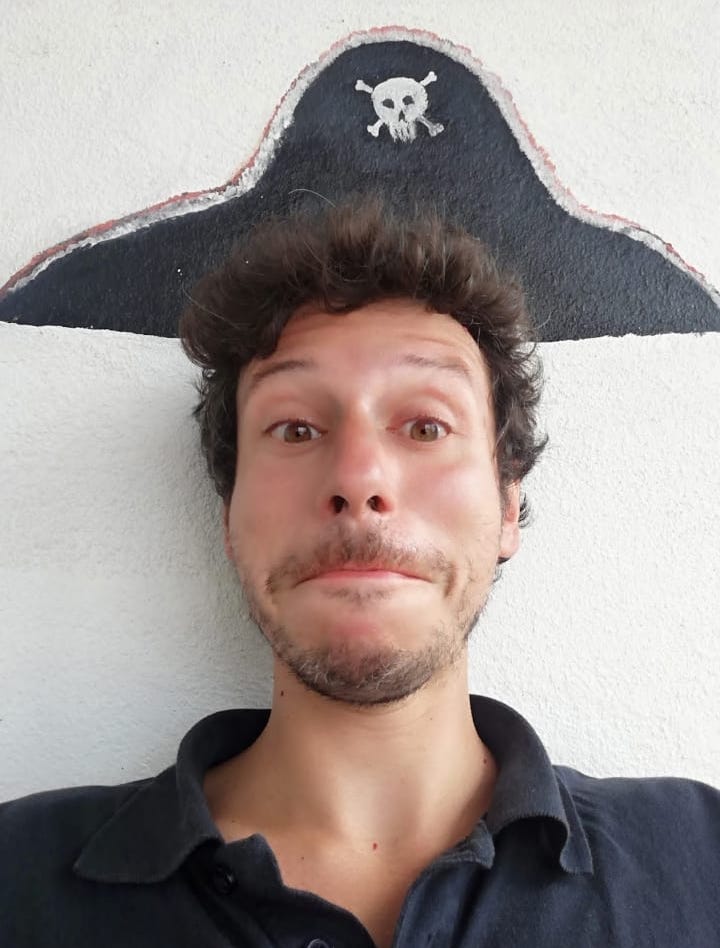OceanX 2023
Exploration and mapping of deep-sea biodiversity in the Azores on board the RV OceanXplorer
Summary
Exploration and mapping of deep-sea biodiversity in the Azores on board the RV OceanXplorer
On this cruise, we operated from the RV OceanExplorer and visited some unexplored areas in teh Azores, such as the geomorphological structures around the Princesa Alice bank and Dom João de Castro seamount, as well as other areas near the slopes of Pico and Faial islands. As in other MapGES cruises, the objectives were to (i) map benthic communities inhabiting unexplored seamounts, ridges and island slopes, (ii) identify new areas that fit the FAO Vulnerable Marine Ecosystem definition, (iii) determine distribution patterns of deep-sea benthic biodiversity in the Azores, and (iv) determine the condition of benthic communities by looking at evidence of fishing damage to fauna, presence of lost fishing gear and marine litter. Moreover, this cruise aimed to collect biological samples of poorly known or unidentified species observed on video footage. The results of these explorations will directly contribute to the Regional Government of the Azores' efforts to declare 30% of the Azores EEZ as marine protected areas of which 10% should be strictly protected. The results of this cruise added to the previous contributions to identify the environmental drivers that determine the spatial distribution of deep-sea benthic biodiversity in the Azores. It also provides valuable information in the context of Good Environmental Status (GES), Marine Spatial Planning (MSP) and new insights on how to sustainably manage deep-sea ecosystems. During the OceanX 2023 survey, we visited several areas in the central group of the Azores, namely D. João de Castro seamount and Princesa Alice bank and the slopes of Faial Capelinhos, Pico S Lajes, and Pico Ponta da Ilha. Taking advantage of the technological assets onboard RV OceanXplorer, namely the ROV Chimaera and the Submersibles Neptune and Nadir, we were able to conduct 8 manned submarine dives and 12 remotely operated vehicle dives, one ROV D. João de Castro seamount, 3 SUB and 3 ROV dives in Capelinhos, 5 SUB and 6 ROV dives in Princesa Alice (Princesa Alice, Princesa Alice W, Bourée E), and one ROV dive in Pico S Lajes and another one in Ponta da Ilha N. From the 20 ROV and SUB dives, 19 were successful. In general, both the ROV and the submersible dives covered a much smaller linear distance (average 952 m) per hour of survey (206 m·h^-1^) when compared to the Azores drift-cam. One of the reasons for the shorter distances was the need to collect biological samples to clarify the taxonomic identification of several organisms. During these dives, we were able to collect 268 biological samples belonging to approximately 197 different morphotypes. It is likely that this sampling effort will help solve about 100 taxonomic questions. After each ROV or submersible dive, we performed a CTD cast to measure water mass properties and collect water samples for more detailed analyses. From the 27 CTD stations, 15 were specifically conducted to address deep-sea related questions, while the other stations were performed to address the Pelagic team objectives. From these 15 dedicated CTD casts, we obtained 157 water samples for different types of analyses.
The OceanXplorer 2023 (OceanX 2023) campaign is the continuation of our long-term strategy to map the deep-sea biodiversity of the Azores and identify areas that meet the criteria for Vulnerable Marine Ecosystems (VMEs) using various imagery systems. Taking advantage of our network of international contacts, we were able to establish a partnership with OceanX, a non-profit initiative by Dalio Philanthropies that “brings science to life through captivating stories”. OceanX owns the RV OceanXplorer, which is equipped with the best and most advanced ocean exploration technology, including submarines capable of diving down to 1000m deep and an ROV capable of working down to 6000m. On this cruise, we visited emblematic and little-explored areas and took advantage of the ship's capabilities to collect biological samples of deep-sea specimens for taxonomic identification. This cruise was also supported under the Contract 18/DRPM/2022, regarding the "Characterization of deep-sea habitats, for its mapping up to the outer limit of the Azores sub-area of the Portuguese exclusive economic zone" acquisition of services between the Government of the Autonomous Region of the Azores, through the Regional Directorate for Maritime Policies (DRPM) of the Regional Secretariat for Sea and Fisheries (SRMP) and the Gaspar Frutuoso Foundation (FGF). It benefits from funding from the European Union under the operation "ACORES-14-62G4-FEDER-000001 - Filling gaps in the characterization of maritime space", within the scope of the reprogramming of the Azores 2020 Operational Program (PO Açores 2020), by incorporating the Recovery assistance for cohesion and the territories of Europe programme (REACT-EU) and by the European Regional Development Fund (ERDF).
Statistics
Highlights
The deep-sea component of the OceanX 2023 expedition revealed that banks and seamounts heavily exploited by bottom longline fishing are still home deep-sea benthic communities with a high natural and ecological value.


Location of operation
Dom João de Castro, Princesa Alice bank, and slopes of Faial island
Stations
OceanX 2023
| Leg | Period | Days at sea | Vessel | Departure | Return |
|---|---|---|---|---|---|
| 1 | 24/08/2023 - 08/09/2023 | 16 | RV OceanXplorer | Horta | Horta |
A total of 16 days at sea
Activities
Funding

Scientific crew

Telmo Morato
Principal Investigator

Marina Carreiro-Silva
Principal Investigator

Filipe M. Porteiro
Senior Scientist

Guilherme Gonçalves
Research Assistant

Manuela Ramos
Student

João Balsa
Research Assistant

Teresa Cerqueira
Early-career Researcher

Gal·la Edery
Research Assistant
Collaborators
Authors list
10.5281/zenodo.4727164





Authors list
10.1594/pangaea.940808


Authors list
10.17882/85926



Authors list
10.17882/86019



Authors list
10.17882/86107



Authors list
10.17882/86110



Authors list
10.17882/86115



Authors list
10.17882/86106



Authors list
10.17882/86103



Authors list
10.5281/zenodo.4727164





Authors list
10.5281/zenodo.4727164





Authors list
10.1594/pangaea.910319


Authors list
10.1594/pangaea.940808


Authors list
10.1594/pangaea.872601

Authors list
10.1594/pangaea.911117
Authors list
10.1594/pangaea.920658


Authors list
10.1594/pangaea.862152

Authors list
10.1038/s44183-024-00078-2

Authors list
10.1016/j.fishres.2023.106877
Authors list
10.1093/icesjms/fsac178


Authors list
10.7717/peerj.16024


Authors list
10.1016/j.pocean.2023.103031


Authors list
10.1016/j.ecolind.2023.111411
Authors list
10.3389/fevo.2023.1050268


Authors list
10.1016/j.ocecoaman.2023.106807


Authors list
10.1016/j.scitotenv.2023.166579





Authors list
10.1093/icesjms/fsac189


Authors list
10.1016/j.ocecoaman.2023.106807


Authors list
10.1016/j.scitotenv.2023.166579





Authors list
10.1016/j.dsr.2023.104028




Authors list
10.1007/s00227-017-3141-x

Authors list
10.1016/j.dsr.2022.103707


Authors list
10.1111/2041-210x.13617
Authors list
10.3389/fmars.2018.00460

Authors list
10.3389/fmars.2020.601798
Location
Departamento de Oceanografia e Pescas — Universidade dos Açores
Rua Prof. Doutor Frederico Machado, No. 4
9901-862 Horta, Portugal
Contact
Email: azoresdeepsea@gmail.com
AZORES DEEP-SEA RESEARCH © 2020-2025 — RELEASE 2.0.3
 VALTER MEDEIROS
VALTER MEDEIROS